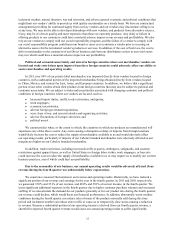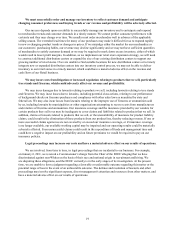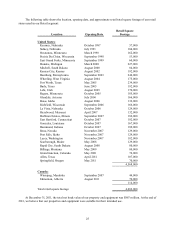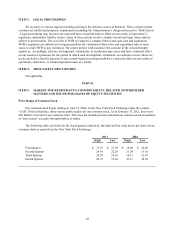Cabela's 2011 Annual Report Download - page 29
Download and view the complete annual report
Please find page 29 of the 2011 Cabela's annual report below. You can navigate through the pages in the report by either clicking on the pages listed below, or by using the keyword search tool below to find specific information within the annual report.19
We must successfully order and manage our inventory to reflect customer demand and anticipate
changing consumer preferences and buying trends or our revenue and profitability will be adversely affected.
Our success depends upon our ability to successfully manage our inventory and to anticipate and respond
to merchandise trends and customer demands in a timely manner. We cannot predict consumer preferences with
certainty and they may change over time. We usually must order merchandise well in advance of the applicable
selling season. The extended lead times for many of our purchases may make it difficult for us to respond rapidly
to new or changing product trends or changes in prices. If we misjudge either the market for our merchandise or
our customers’ purchasing habits, our revenue may decline significantly and we may not have sufficient quantities
of merchandise to satisfy customer demand or we may be required to mark down excess inventory, either of which
would result in lower profit margins. In addition, as we implement our retail store expansion strategy, we will need
to construct additional distribution centers or expand the size of our existing distribution centers to support our
growing number of retail stores. If we are unable to find suitable locations for new distribution centers or to timely
integrate new or expanded distribution centers into our inventory control process, we may not be able to deliver
inventory to our retail stores in a timely manner, which could have a material adverse effect on the revenue and
cash flows of our Retail business.
We may incur costs from litigation or increased regulation relating to products that we sell, particularly
tree stands and firearms, which could adversely affect our revenue and profitability.
We may incur damages due to lawsuits relating to products we sell, including lawsuits relating to tree stands
and firearms. We may incur losses due to lawsuits, including potential class actions, relating to our performance
of background checks on firearms purchases and compliance with other sales laws as mandated by state and
federal law. We may also incur losses from lawsuits relating to the improper use of firearms or ammunition sold
by us, including lawsuits by municipalities or other organizations attempting to recover costs from manufacturers
and retailers of firearms and ammunition. Our insurance coverage and the insurance provided by our vendors for
certain products they sell to us may be inadequate to cover claims and liabilities related to products that we sell. In
addition, claims or lawsuits related to products that we sell, or the unavailability of insurance for product liability
claims, could result in the elimination of these products from our product line, thereby reducing revenue. If one or
more successful claims against us are not covered by or exceed our insurance coverage, or if insurance coverage
is no longer available, our available working capital may be impaired and our operating results could be materially
adversely affected. Even unsuccessful claims could result in the expenditure of funds and management time and
could have a negative impact on our profitability and on future premiums we would be required to pay on our
insurance policies.
Legal proceedings may increase our costs and have a material adverse effect on our results of operations.
We are involved, from time to time, in legal proceedings that are incidental to our business. For example,
on January 6, 2011, we received a Commissioner’s charge from the Chair of the EEOC alleging that we have
discriminated against non-Whites on the basis of their race and national origin in recruitment and hiring. We
are disputing these allegations, and the EEOC currently is in the early stages of its investigation. At the present
time, we are unable to form a judgment regarding a favorable or unfavorable outcome regarding this matter or the
potential range of loss in the event of an unfavorable outcome. The defense and resolution of lawsuits and other
proceedings may involve significant expense, divert management’s attention and resources from other matters, and
have a material adverse effect on our results of operations.
























